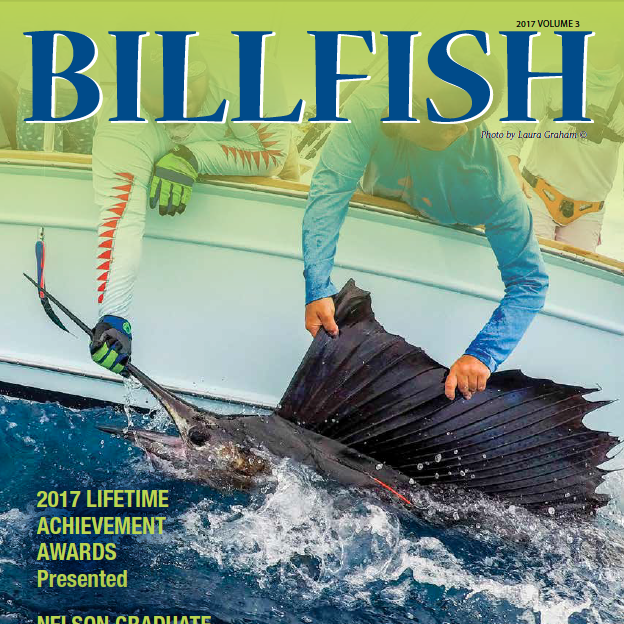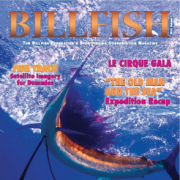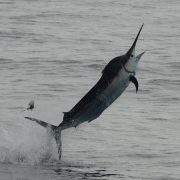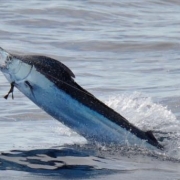Sailfish Satellite Tagging in Palm Beach
On March 13th, TBF’s Peter Chaibongsai and TJ Morrell met up with the crews, and research team in Singer Island, Florida to discuss logistics for the upcoming satellite tagging trip. The goal: satellite tag Atlantic sailfish over the next two days. With only a few instances of Atlantic sailfish being satellite tagged here in South Florida recently, the group was excited and anxious to begin!
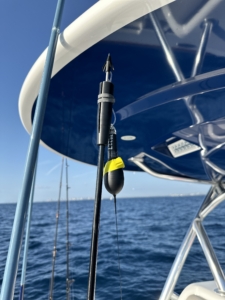
Archival Pop-Up Satellite Tag prepped on TBF tagging stick.
Three vessels would be heading out on this research expedition, each carrying two satellite tags to enhance the potential for tag deployment. The research team from the University of Southern Mississippi (USM), Jeremy Higgs, and Angie Hoover, along with Peter and TJ would be spread throughout these three vessels to provide the optimal chance of a successful tag deployment. The first vessel, a 70 ft sportfishing yacht called Old No. 7 is owned by TBF board member Austin Musselman, who is also responsible for donating three of the satellite tags used in this research project. The captain of his vessel, Jamie Ralph (a past TBF tagging winner) would be running the offshore operations along with his professional crew. The next vessel, a 33 ft Valhalla named Lily is owned and operated by TBF supporter Mike Samuels of Teams Marine. The last vessel, a 39 ft SeeVee named Encore, was run by Jamie Bunn, founder of Bluewater Movements Tournaments. Bluewater Movements and Old No. 7 captured and documented this occasion, including interviews with TBF, the USM research team, and every member of the crew involved.
Despite the Atlantic Sailfish being Florida’s state saltwater fish, there is always more information that can be obtained from this species, especially when given the opportunity to deploy satellite tags. Compared to traditional “dart” or “spaghetti” tags, satellite tags provide researchers with finite, real-time data and can reveal insights into sailfish behaviors. Satellite tags can offer an incredible amount of information over a short time and can be useful for projects associated with migrations, vertical movements in the water column, and locational/seasonal trends. For this project, the tags would remain on the fish for periods ranging from one to 12 months, before safely detaching from the sailfish and floating to the surface. Another unique aspect of this trip was that last year’s champion of the Bluewater Movements Sailfish Challenge, Team Remix, would have the opportunity to name the inaugural satellite tag deployed.
Once fishing commenced on Wednesday morning, there was a quick, initial bite, but the majority of the first day was fairly quiet, only seeing five sailfish on the day and successfully deploying a satellite tag on one. Fortunately, things were more favorable on day two, allowing four satellite tags to be deployed between two of the vessels. By the time all vessels returned to the dock at the end of the day, smiles could be seen in every direction! From here, all involved will have to wait for the tags to successfully report and the scientists to review the data. TBF will then utilize the analysis to continue to highlight and offer insights into these incredible and valuable species, as well as provide better fisheries management policies to the region.
Only through satellite tagging can some of the data gaps associated with the life history of sailfish be filled. Though much research has been done through our satellite tagging efforts, there is still a great amount of information that is unknown to us. If you are interested in sponsoring or participating in a satellite tagging expedition with The Billfish Foundation, you can do so by contacting us at tag@billfish.org.
We want to thank everyone who helped make this research trip possible. From the donation of the satellite tags, to the research team from USM, to the captains and crews of all the vessels that made this possible, we at TBF thank you!



